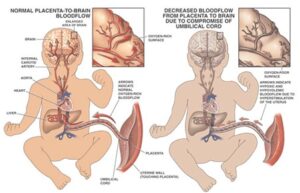Birth Injury Claims: Hypoxic Ischaemic Encephalopathy
Stern Law is led by Principal Solicitor, Terry Stern, one of the most experienced medical negligence lawyers in NSW with over 35 years’ experience in the field and an Accredited Specialist in Personal injury Law. Some of his landmark cases include:
Our Commitment: Stern Law is dedicated to a team approach, drawing on a variety of skills and backgrounds in medical negligence law to get our clients the best results.
Childbirth and pregnancy can be dangerous and complicated and when things go wrong, the neonate can be severely compromised. One of the most common complications that arises out of birth injury is Hypoxic-ischemic encephalopathy (HIE).
What is HIE?
HIE is a type of neonatal brain damage which is caused by limited blood flow, creating oxygen deprivation. It occurs in 1 to 5 births per 1,000.[1]Terms used interchangeably for HIE include: ‘birth asphyxia’, ‘neonatal encephalopathy’ and ‘neonatal hypoxia’.[2]
Key terms defined:[1]
Hypoxic = low oxygen
Ischemic = restricted blood flow
Encephalopathy = altered brain function

When fetal compromise is identified, HIE can be prevented through immediate delivery via emergency caesarean section or vaginal birth if birth is imminent.
Medical Negligence
Although there are many instances where physiological processes in birth can lead to neonatal compromise, unfortunately sometimes obstetricians will miss opportunities to diagnose or treat complications exacerbating the risk of HIE, or instead, performed actions negligently which have induced HIE to the neonate.
Causes of birth asphyxia and HIE:
- Uterine hyperstimulation (often from labour augmentation methods e.g., synthetic prostaglandins or oxytocin)
- Cord prolapse
- Placental abruption
- Uterine Rupture
- Abnormal fetal position/ presentation
- Delays in emergency caesarean section
- Failure to recognise fetal distress and improper fetal monitoring
Complications of HIE:[1]
- Cerebral palsy
- Epilepsy
- Hering or vision loss
- Developmental delays
[1] Healthline ‘Hypoxic-ischemic encephalopathy’
[1] Cleveland Clinic ‘Hypoxic-ischemic encephalopathy (HIE)’
[1] Healthline ‘Hypoxic-ischemic encephalopathy
Clinical Signs and Diagnosing HIE in the neonate:
- Poor APGAR scores
- Need for resuscitation
- Seizures
- Feeding difficulties
- Abnormal neonatal reflexes
- Organ failure
- Fetal distress in labour
A medical practitioner should complete further tests if HIE is suspected:
- Umbilical cord blood testing immediately post birth to determine fetal acidosis (low oxygen)
- Placental investigation
- Head Ultrasound
- ECG to check brain activity.
Did You know?
In 1952, Dr. Virginia Apgar,[1] an anaesthesiologist at Columbia University, developed the Apgar score. APGAR is a useful mnemonic to describe the components of the score: appearance, pulse, grimace, activity, and respiration.
Source: Thoughtco
It is a quick test completed by healthcare providers to evaluate the baby’s conditions immediately after birth and determine if the baby needs assistance with the transition to extrauterine life. The baby will be assessed at 1 and 5 minutes post birth. If your baby scored poorly, it is required that healthcare providers intervene to provide treatment through neonatal resuscitation techniques.

Source: Pinkorbluecare.com
Treatment for HIE
Babies suffering from HIE can require several treatments in the Neonatal Intensive Care Unit. One of the most effective and important is therapeutic hypothermia or ‘cooling therapy’. This involves lowering the baby’s body temperature to reduce further brain injury and help protect the brain from the effects of the lack of oxygen and blood flow.
Brain injuries from HIE can cause:[1]
- Developmental delays
- Intellectual disabilities
- Epilepsy
- Cerebral palsy
- Heart problems

Compensation
HIE in the neonate can be a terrifying and traumatic experience for new mothers, fathers, and their families. It can take some time to process the ordeal and start to make sense of the events which unfolded. If you believe that your care was mishandled by a medical practitioner and did not meet the standard of care required, exacerbating the circumstances of HIE injury to your baby, you likely have grounds for a medical negligence claim.
For further information about your birth details, contact your birth provider for a clinical debrief, or alternatively our medical negligence specialists can directly request your personal records, with your consent.
At Stern Law, we understand the sensitive nature of HIE, with empathy and compassion, we will guide you every step of the way.
Please call us on (02) 9387 1399 or email us at [email protected]
We look forward to sharing this journey with you.
Disclaimer: The content of this article is intended only to provide a summary and general overview of matters of interest. It does not constitute medical or legal advice and should not be relied on as such.
Image References
APGAR figure: The Apgar assessment. (Image by Event Medicine Group)





